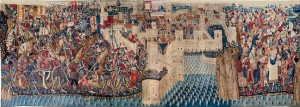
Probably produced under the direction of Passchier Grenier, tapestry merchant, Tournai (Belgium), detail, 1470s, Fall of Tangier, 1475-1500, wool and silk, 157-1/2 x 426 in., Diocese of Sigüenza-Guadalajara and Church of Our Lady of the Assumption, Pastrana, Spain
On view now and continuing until May 13th at the Meadows Museum in Dallas (SMU campus), visitors can view a set of four fifteenth-century tapestries. These tapestries have been preserved since at least the seventeenth century at the Collegiate Church of Nuestra Señora de la Asunción in Pastrana in the Spanish province of Guadalajara. These beautifully woven tapestries were created sometime in the last quarter of the 15th century and came out of the Tournai workshops in Belgium. It is widely thought that they were given to King Philip II by Rui Gomes da Silva (1516-73), prince of Éboli (and later the first duke of Pastrana), around the time of the union of Spain and Portugal.
These intricate tapestries are unique in that most tapestries of their time would characteristically depict Biblical or mythological subject matter. The Pastrana Tapestries are some of the few of the period that depict current events such as the conquest of the North African cities of Asilah and Tangier by Afonso V (1432-81), King of Portugal. Measuring 36 feet in length and 13 feet in height, the tapestries were commissioned by Afonso V and show amazing detail and descriptions of Portugal’s expansionist victories at the time of the Crusades.
Recently, the tapestries underwent a 2 year renovation in order to restore theme to their original splendor. The Meadows Museum is their first American stop after the National Gallery of Art in Washington D.C. So, Dallas, we are indeed privileged to have the opportunity to view these exquisite fifteenth-century works of art!
